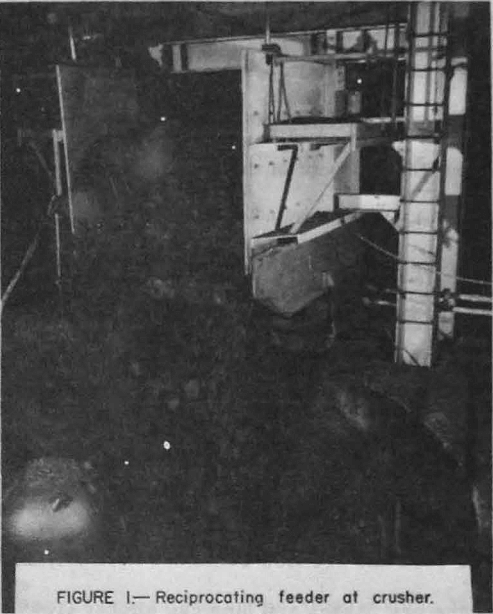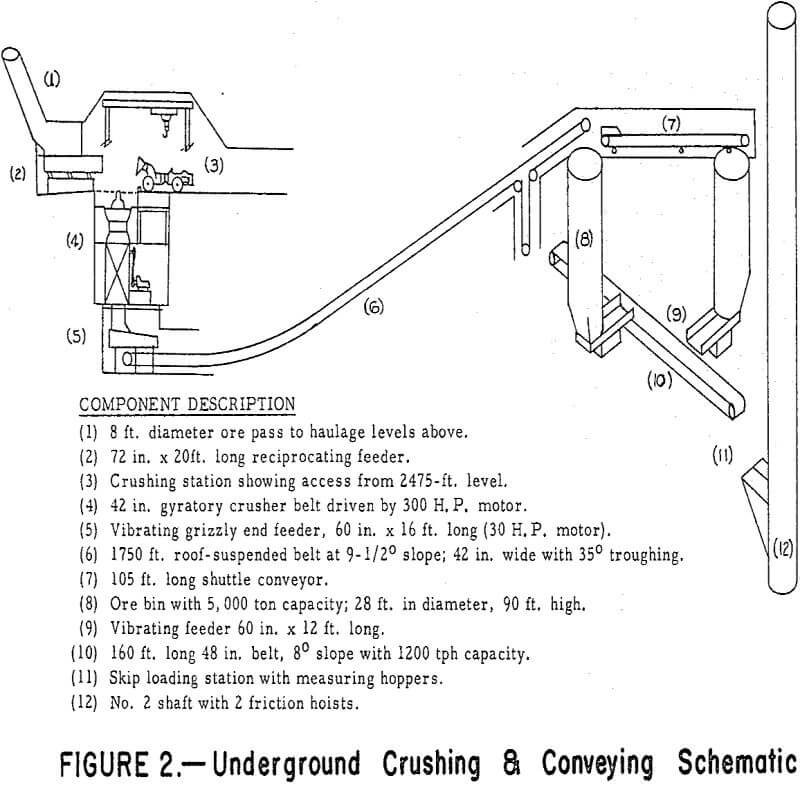Table of Contents
Meramec Mining Company, a joint venture by Bethlehem Steel Corporation and St. Joe Minerals Corporation, is engaged in the mining, concentrating, and pelletizing of iron ore from the Pea Ridge Mine located near Sullivan, Missouri, about 70 miles southwest of St. Louis.
Crusher and Conveyor System Layout
The heart of this system is a 42-inch gyratory crusher on the 2475-foot level. The manufacturer agreed to split the top shell, making it possible to lower such a large crusher down No. 1 shaft. This is fed by a 72-inch wide by 20-foot long reciprocating feeder which empties the ore pass system from the four Swedish-style dumps above. Liner wear in the reciprocating feeder is monitored from outside with an ultrasonic thickness tester, and replacement is scheduled according to this ultrasonically measured thickness. The crusher drops ore into a small surge bin and then onto a 60-inch wide by 16-foot long vibrating feeder with a 4-foot long grizzly end which in turn feeds the conveyor. Feed rate is monitored by the crusher operator via closed circuit TV.
The operator’s control room houses the main control panel which by means of push buttons, indicator lights, alarm panels, motor ammeters, and closed circuit television allows total monitoring of the system up to the tops of the ore bins. This control room also contains all of the 480-volt motor controls for the crushing station. Starting equipment for the 4160-volt crusher motor and conveyor drive is located separately from the control room for safety reasons.
The ore is either fed directly into No. 1 ore bin or onto a 105-foot long, 42-inch shuttle conveyor which then conveys the ore to No. 2 ore bin.
Decline Chosen to Develop Crusher Level
The shafts are 2500 feet deep, but to try to establish a new level from either of them meant an intolerable interruption in hoisting. It was therefore decided to drive a 15.8% decline from 2275-foot level to 2475-foot level.
Since the eventual mucking vehicle was to be a 5-yard LHD unit and because it was desired to accommodate any vehicle that might use it in the future, the size of the decline was set at 12 feet high by 15 feet wide. Drifting was started with three-man crews using three jackleg drills, a crawler-mounted overshot loader and two 1-yard 3-wheeled diesel trucks.
With bolting and pumping times considered, the average 8-foot round took 1. 3 shifts. This time increased as the face moved away from the waste dump. In August, 1966 a 5-yard LHD unit replaced the overshot loader and trucks (one truck was retained for drilling). Mean mucking time was reduced to 1 hour 10 minutes from 2 hours 35 minutes. Tramming distance at that time was almost 900 feet and mucking time continued to increase arithmetically as the decline advanced. In September, a three-boom jumbo on a diesel-powered carrier supplanted the jackleg drills.
Longhole Methods of Excavating
In April, 1968 the primary objectives the crushing station and the crushed ore bin sites were reached and excavation began. The dimensions of the crushing station were determined at 20 feet wide by 27 feet 9 inches high by 102 feet long. In order to excavate the station, one end was slotted and the width was entirely overcut to permit excavation by longhole drilling. Blasting was done with AN/FO. Fragmentation was good and overbreak was minimal, requiring only routine scaling and bolting to secure the walls. The chamber in the floor of the crushing station which would contain the crusher was cut with longholes utilizing a longhole or “drop” raise as the cut. A 21-foot diameter cylinder with a 14-foot wide by 17-foot 8-inch long “tail” was undercut by the conveyor drift below.
The ore bins, each 28 feet in diameter and 90 feet deep, were cut in much the same manner as the crusher chamber. Undercutting the bins reduced the depth of hole required to 73 feet. To achieve a smoothwall effect, 2-¼- inch diameter holes were spaced 3 feet apart around the periphery of the bins.



